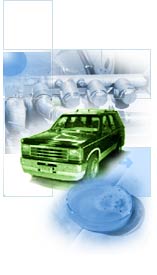  |
|
|
 |
CSA MESSAGE | PATENT PORTFOLIO | WHITE PAPER - HYDROGEN ON DEMAND™
The Hydrogen on Demand™ System
Sodium
borohydride (NaBH4), a salt, is dissolved in water where
it stays until gaseous hydrogen (H2) is needed. This is
the left side of the reaction. When H2 is desired, the
NaBH4 solution is pumped over a catalyst. This is the arrow in the
center of the reaction marked "cat". The H2 gas comes
out, and leaves behind sodium borate (NaBO2), another
salt, which remains dissolved in water. This is the right side of
the reaction. To stop the left to right progression of the
H2 generation reaction, the pump stops and the solution
is kept from the catalyst. Without the catalyst, the H2
generation does not occur.
These points are all critical if the goal is to have a practical transportation fuel. Most important is the idea that on board a car, borohydride fuel will be stored in a tank just like the ones cars use today. The tank can be made out of plastic, molded to match the shape of an automobile chassis, and will be essentially the same size as the standard gas tank. The rest of the system is reasonably compact. According to the ideas discussed above the fuel needs to be in contact with the catalyst. To accomplish this task in a car the fuel is pumped to a chamber containing the catalyst. The chamber releases all of the H2 from the borohydride in one pass, enough to power the car, and the remaining borate goes to a spent fuel tank. When H2 is no longer desired, the pump is shut off, isolating the catalyst from the fuel. By turning the pump on and off, the hydrogen flow is easily controlled. Increasing and decreasing the rate of pumping can also affect a much finer control of the H2 generation rate. While cars are
very interesting, Hydrogen on Demand™ can also be employed in off
board applications. Small systems have been designed which do not
even require pumps, using only pressure differences to move fuel to
and away from a fixed catalyst. All in all, Hydrogen on Demand™ is
proving to be a very flexible method of supplying hydrogen to fuel
cells and engines of various sizes, without any
emissions. |
 |
ABOUT US | INVESTOR RELATIONS | TECHNOLOGY SOLUTIONS | THE MARKET | NEWS/EVENTS | CAREERS | CONTACT US | HOME
Copyright © 2001 Millennium Cell, Inc.
